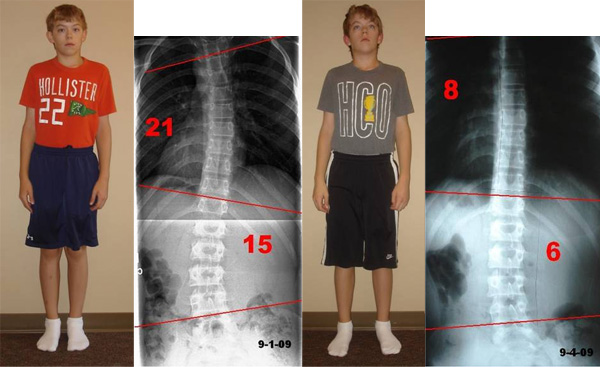Close to 500,000 adults in the United States have scoliosis with several thousands who have not been diagnosed. Our austin chiropractic clinic has successfully treated (halted scoliosis and improved curvature) for over 200 scoliosis patients. Scoliosis is an abnormal lateral curvature of the spine of 10 degrees or more. There are 3 classes of scoliosis: Mild, Moderate and Severe.
- Mild scoliosis is a 10 to 25 degree curvature and carries a significant risk of progression (up to 22%). Once the scoliosis passes 20°, risk of progression more than triples to 68%! prevent a severe health crisis.
- Moderate scoliosis is a 26 to 40 degree curvature and carries a 68% chance of progression. Often patients notice symptoms such as pain or headaches and loss of balance. Clothes can hang unevenly and postural imbalances are noticed. Many patients struggle with poor body image, social anxiety, and depression.
- Severe Scoliosis is a curvature of 40 degrees and more and carries a 90% risk of progression. Patients often experience chronic pain and headaches, loss of balance, and digestive disorders. Clothes hang unevenly and severe postural imbalances are noticed, including a “rib hump” and off centered belly button. Many times the spine is visualized as a “C” or “S” shape when viewing the skin. Many patients struggle with poor body image, social anxiety, and depression.
How does scoliosis develop?
Forward head posture and loss of normal alignment of the neck has been determined to be the leading cause of scoliosis. Unfortunately many suffering from scoliosis today have never been told so. Ligament laxity is the next most likely reason as well as a contributor to pain and discomfort. Sometimes it is the result of a birth defect. Scoliosis occasionally develops later in life. One fourth of such cases are caused by polio, cerebral palsy, juvenile osteoporosis or other diseases. No cause for the ligament laxity can be found in the other 75 percent of cases of late development of scoliosis.
What are the symptoms of scoliosis?
Mild forms of scoliosis usually have no symptoms, although long periods of standing or sitting can cause a fatigued back as well as neck pain and back pain. This mild fatigue can develop into muscular pain that eventually becomes extreme. Pain is often felt at the apex of the curve, or the point where the spine curves out the most, which is where the ligaments are stretched the most.
Spinal curvatures often lead to misaligned shoulders – typically a raised right shoulder that curves down toward the left part of the lower back. One hip may also be disproportionately higher than the other. A routine physical examination, including physical inspection and X-rays, can usually determine if a child has scoliosis.
What are the common treatments of scoliosis?
Being diagnosed with mild scoliosis can be a scary moment. While mild scoliosis is found within males and females of all ages, it’s very commonly found within teenage girls. The vast majority of “mild” scoliosis cases are recommended for a “sit and wait” approach to care. This is no only irresponsible but devastating considering that new research and spinal correction techniques have been shown to correct mild scoliosis.
The use of a scoliosis brace is often the next traditional treatment method recommended. If bracing does not work, your doctor may recommend surgery.
True correction can only occur when both the structure (spine alignment) and function (muscular weakness and imbalances) have been restored.
Think Corrective Chiropractic may be for you? Call us!
To experience Family Health Chiropractic for yourself or your family, schedule a consultation via email or call us at 512-347-8881.
Family Health Chiropractic is a full time natural medicine doctor’s office. We have successfully treated all of the conditions we write about. The difference is in the care, technique, and experience you get with Dr. Daniel and his team at Family Health Chiropractic.

